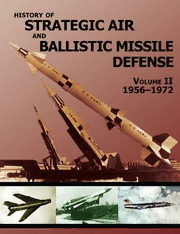
History of Strategic and Ballistic Missile Defense Volume II 19561972 PDF
Preview History of Strategic and Ballistic Missile Defense Volume II 19561972
HISTORY OF STRATEGIC AIR AND ^ BALLISTIC MISSILE DEFENSE V Volume II 1956-1972 * ExecutiveSummary A. Introduction Thisisthesecondoftwodraftvolumesonthehistoryofstrategicairandballisticmissiledefensefrom 1945to1972.Itcoversthe1955-1972portionofthelargerperiod,andisorganizedintofiveinterrelated andprogressivelymoredetailedchapters.ChapterIprovidesacomparisonofU.S.andSovietstrategies, ChaptersIIandIIIdealwithU.S.strategyandSovietstrategy,whileChaptersIVandVcoverU.S.systems andSovietsystems. ThisExecutiveSummaryisdrawndirectlyfrom,andhighlightscriticaljudgmentsof,thesefivechap- ters.Assuch,itoutlinesthesubstanceofthemuchlargerbodyofprimaryevidencecontainedinthesepa- ratebooksinthisdraftvolumewhichwasgatheredtoaddressthereasonsunderlyingpolicyformulation anddecisionmakingforstrategicdefenseandtherelationshipbetweenthesuperpowerswithinthathighly complexsecuritypolicyarena.Resultsofresearchconcerningfactorsinfluencingattitudesofpolicy/deci- sionmakersatcriticaltimesappearinChaptersIIandIII. ThisExecutiveSummaryhasthreemajorgroupings:one,toreflectthecontextualsettingofdeci- sion-making,circa1955;thesecond,tohighlightstrategicairdefensepolicycomparisonsandcontrasts, 1955-1972;andathird,topresentjudgmentsandconclusionsabouttheresultsoftheplayoffactorsand perceptionswhichmoldedairdefensedecisionsduringtheseyears.Thesethreesectionsderivefromand arefirmlytiedtoanevidentialbase;however,timeanddocumentationconstraintshavelimitedtheeffortto developthatbase.Consequently,importantelementsofthestorymayappeartobeslighted.Theessential andsignificant,however,arehere. CentralquestionsfacedtheU.S.andSovietdefenseplanners.Fundamentallytheyasked:"Howto defendthecountry?"and"Howmaywebeattacked?" B. TheSetting 1. InfluentialFactors Duringthisperiod,U.S.andSovietperceptionsofstrategicairandmissiledefenserequirementswere stronglyinfluencedby(1)scienceandtechnology,(2)uncertaintiesinthefutureenvironmentastothe continuityoftheother'spoliciesandnuclearstrategies,and(3)thegrowingwishtomovetowardsome limitationsonarms. 2. Contextin1955 a.U.S.StrategyandPolicy U.S.nationalpolicycalledforastrongandeffectivesecurityposturewithemphasisonstrategicretal- iatoryforcesandanintegratedcontinentaldefensesystem.U.S.continentaldefensepolicycalledfor 1 HistoryofStrategicAirandBallisticMissileDefense,1956-1972:VolumeII intensificationandaccelerationofprogramsinordertobepreparedagainstaSovietthreatanticipatedtobe grievousby1957.Disarmamentarrangements,ifpracticable,wouldbesought. b.SovietStrategyandPolicy SovietstrategyintheSpringof1955builtonafundamentallychangeddoctrineofpreemptiondesigned tofrustrateanenemyattack.Thisprovidedthebasisforhavingstrategicforcesnotonlyforoffensive employmentbutalsotodisruptaWesternsurpriseattack.Inaddition,theSovietshadanactivedefense systemtohelpsecureagrowingstrategicdeterrentforceandtodefendthehomeland.Amissiledevelop- mentprogramwasbeingpushed. 3. GeneralOverview a.FactorsInfluencingDeterrence Concernoveraperceivedvulnerabilitytoasurprisenuclearattackledbothnationstodeveloppowerful deterrentforcesandsupportingpostures.Technologywasthepredominantfactorinfluencingthecharacter ofthestrategicchoicemadeduringthisextendedperiodfornationaldefense.Deterrentstrengthwasbasic tonationalsecurity. TheUnitedStatesandtheSovietUnionsharedthebasicchoicethatwasmade.Bothlookedtoaninte- gratednationalairdefensesystemasoneelementofdeterrence.TheweightedemphasisoftheU.S.choice wenttothestrategicoffensiveelementofthedeterrent;theSovietdeterrentinclinedtoamorebalanced posturebetweenoffensiveanddefensivecomponents. Asthedeterrentforceofthetwonationsevolved,threatperceptionsinfluencedtheircharacter. Baseduponaperspectiveofthemid-1950's,theUnitedStatesdecidedthatthedeterrentstrategy requiredthehighprioritydevelopmentoflong-rangemissiles.Theequivalentlevelofprioritydidnot attendprogramsforstrategicairandmissiledefensealthoughthethreatprojecteddistinctiveneeds foractivedefense. AreversedsetofprioritiesguidedtheSovieteffort;responsetothethreatofU.S.strategicoffen- sivepoweremphasizedtheneedforanactivedefensethroughoutthisperiodwhilebuildingupstrategic forces. b.FactorsInfluencingAirandMissileDefenseDecisions Inthecontextoftheexistingbasicnationalsecuritypolicy,U.S.strategicairandmissiledefense contributedtotheU.S.deterrentposturewhilethethreatchangedandnewtechnologicaldevelopments appearedtochallengevariousaspectsoftheestablishedstrategy.PrimefactorsbearingontheU.S.strategic decisionsconcerningairandmissiledefenseduringthisperiodincludedthethreat,technology,andbudget- aryconstraints. Sovietstrategicconceptsandplanningforacontinuing,upgradedairdefensestructureandABM deploymentwereinfluencedbythesamefactorsandthisaccountsforobvioussimilaritiesinthepatternof basictrends.ThenatureandrationaleofSovietdecisions,however,involvesspeculationalthoughtheavail- ableevidenceclearlyshowsthatthepoliticalleadershipsetprioritiesforstrategicdefenseandregularly allocatedasubstantialresourcecommitmenttothateffort. 2 ExecutiveSummary C. StrategicActions 1. ParallelDecisionsDuringthePeriod ActionsofconsequencetotheU.S.andSovietstrategicairandmissilesystemsaredetailedinChapters IIandIII.Amongthoseactions,certaindecisionsstandout.Noteworthyfortheirrelativesignificance, thesedecisionshaveaddeddimensionbecausetheU.S.andSovietUnioneachchoseparallelroutesintheir approachestosecurity. a.Mid-1950sBuild-Up TheUnitedStatesandtheSovietUnioneachdecidedearlyintheperiodtobuildupthestrategic airdefensestructureexistingatthetimebaseduponperspectivesofthecurrentandanticipatedmanned bomberthreat.Ineffect,thesedecisionsextendedandreinforcedearlierdecisionstoestablishthenational airdefensesystems.Givenaddedimpetusinthemid-1950'sbydecisionsforbuild-up,eachofthenational systemsgeneratedamomentumforacontinuationoftheestablishedpatternofactionwithrespecttoair defense.Eachacquiredaself-sustainingdimension. IntheSovietUnionthisinfluencedsubsequentdecisionsinvolvedintherevampingoftheNational AirDefenseForceswhichtookplaceaspartofKhrushchev'sgeneralreorganizationofthearmedforces (SectionC,ChapterIII,"MajorDecisions").Reductionsinfighteraircraftandthevirtualeliminationof antiaircraftartillerywerenoteworthyelementsofthisrestructuring.Theseactionscoincidedwiththeavail- abilityofanewsurface-to-airmissilesystem,theSA-2,andtheadvanceddevelopmentoftheSA-3. 1) FactorsRelatedtoSovietDecision Theavailabilityofthesemissilesystemsandnewfightersandimprovedearlywarningandcommuni- cationslinks,itispresumed,enabledKhrushchevtoaccomplishresourcesavingswithinthestrategicair defenseforceinkeepingwithhislarger,basicreo—rganizationofthearmedforces.Thus,itcanbeinferred thattheavailabilityoftheproductsoftechnology thenewSAMs,fighteraircraft,radarsandcommunica- — tionlinks resultingfromdecisionsandactiontakenearlierfacilitatedthisSovietdecision.Theeconomic situationremainedgenerallypoordespiteariseinmilitarybudgetsaboutthetime.Sovietthreatperceptions hadtotakeintoaccountabout1,500U.S.strategicaircraft,includingtherecentlyintroducedB-52.U.S. navalaircraft,theRAFandanembryonicballisticmissilethreatwereaddedproblems.Confidenceamong theSovietleadership,however,washighasadirectresultofthestunningachievementoftheSputniks; Khrushchev'sauthoritywasaccepted;hewasrespectedastheprincipalleaderandhehadalreadymadethe largerstrategicdecisionsonoffensivemissiles.Toupgradethenationalairdefensestructurewastherefore, anaturalprogression. 2) FactorsRelatedtoU.S.Decision a) ThreatPerceptions Threatperceptionsanddecisionprocessesappeartobetheprimefactorsinthisdecision.Anupdated specialintelligenceestimatecurrentatthestartofthisperiodheldthatby1957theU.S.S.R.coulddevelop thecapabilityoflaunchingapproximately1,000aircraftinaninitialairoperationagainsttheUnitedStates. WhileitconsidereditmorelikelythattheU.S.S.R.wouldelecttocommitsubstantiallyfewer,thisestimate 3 HistoryofStrategicAirandBallisticMissileDefense,1956-1972:VolumeII believedthat550missionaircraftwouldconstitutethemaximuminitialeffort(ChapterIandAnnexV, ChapterII). EssentiallylimitedprogresshadbeenmadeintheairdefenseprogramsalreadydirectedbyPresident Eisenhower.TherewasconcernbecauseofrevisedintelligenceestimatesconcerningtheSovietnuclear stockpileandfeararousedbytheprospectsofthefallouthazard.(AnnexV,ChapterIIdealswithestimates, assessmentsandkeydecisionsatthetime.)TherealsowasgrowingCanadianconcern.TheKillianreport, "MeetingtheThreatofSurpriseAttack,"pointedupSovietcapabilitiesinearly1955,andindicatedcritical U.S.targetswererelativelyfewsayingthat"200nuclearbombs...woulddecisivelydefeatusand...a firstattackcouldbefatalifweweresurprisedandunprepared."TheKillianreportspecifiedanumberof deficienciesoftheU.S.airdefensesystem.WSEGReportNo.15,"ContinentalDefense,"whichcirculated duringthesummerof1955,containedavarietyofrecommendationsonthesubject.Manyseparategroups wereurginghighlevelU.S.Governmentactionforimprovedairdefense. b) DecisionProcess InthehighlystructuredU.S.nationalsecurityorganization,thepolicyprocesswasinstitutionalized, butdependentonvariousadhocgroupsfortechnicalassessmentsandevaluations.Decisionsresulted fromtheevidencesuchgroupsdevelopedconcerningtheneedforactiononstrategicprograms.In1953, PresidentEisenhower'sReorganizationPlanNo.6hadrevisedthefunctionsoftheU.S.ArmedForcesand thechainofcommand,abolishedtheMunitionsBoardandResearchandDevelopmentBoard,established sevenAssistantSecretariesofDefense,and,intheNationalSecurityCouncil,majorpolicyquestionsand securityissueshadbecomethepurviewofthePlanningBoard,madeupofrepresentativesdrawnfromthe DepartmentsofState,Defense,andTreasury;theOfficeofCivilandDefenseMobilization;andtheBureau oftheBudget. ThisBoard,whichincludedadvisorsfromtheJCSandCIA,hadmemberspersonallyappointedbythe PresidentuponnominationofthedesignateddepartmentsandagenciesandtheapprovalofthePresident's SpecialAssistantforNationalSecurityAffairs,RobertCutler,aprominentBostonbanker.ThePlanning Board,whileonlyasmallpartoftheNSCsystemunderPresidentEisenhower,constitutedtheheartof theU.S.securitystructuresinceithadthecentraltaskofformulatingpolicyfortheconsiderationofthe CouncilandtheapprovalofthePresident.Boardconsiderationofanissuebeganwiththepreparationofa preliminarystudyanddiscussion.Followingthisadraftwouldbeprepared,modified,andclearedthrough inter-agencycoordination.Specialstudiesofairdefenseproblemsabounded. b.Long-RangeMissileDevelopment—Deployment—Mid-1950's TheSovietUnionandtheUnitedStateseachdecidedearlyintheperiodtopursueaccelerateddevelop- mentanddeploymentoflong-rangeoffensivemissilesystems.Thesedecisionsweresignificantbecauseof theirdirectconsequenceswithrespecttothechoiceofbasicstrategyandbecauseoftheaddeddimension theygavetotheevolutionofthreatperspectives. 1) FactorsRelatedtoSovietDecision Thepromiseoftechnologyappearstohavebeenaprimaryfactorinthisdecision.TheSovietsneededa deterrenttoneutralizeU.S.strategicairandmissilebasesinEurope,toholdEuropehostageagainstaU.S. threatofaction,andtosupportstrategicconceptsfortheoperationsthecombinedarmsagainstEurope. 4 ExecutiveSummary AstrongSovietsecuritypositionwasneeded;adeterrentforcecontributeddirectlytothedefenseofthe homeland.Technologyofferedtheprospectofanimpressivesolutiontothethreat.Khrushchevwouldboast thatthestrategicattackaircraftwasobsolete.Hehaddecidednottoproducealargebomberforce.Rockets andmissilesweremanifestationsofagrowingSovietemphasisonthesenewmeansforwieldingnuclear power. NuclearpowerhadalreadyprovenusefulforSovietstrategicpurposes.TheUnitedStateshadshown interestindetenteduring1955and,despiteitscommitmentto"massiveretaliation,"eventsinSuezand Hungary'thefollowingyearindicatedthatthepatternofpowerinworldpoliticswaschanging.Eventsinthe fallof1956showedthateffortstoimposepoliticalchangebyforceattheexpenseofanothermajorpower couldinducegreatriskinthenuclearera.Sovietnuclearthreats,however,wereblatantatthetime;their diplomaticsuccessnowseemsincredible. 2) FactorsAffectingtheU.S.Decision ConcernovertheSovietbomberprogramandtheICBMthreatcombinedtomakethreatperceptiona principalfactorrelatingtothisU.S.decision.Technologyalsowasofgreatsignificance,andrelatedtothis decisionwasanintense,bitterwrangleoverrolesandmissionsandbureaucraticpolitics.TheSovietICBM testandlatersuccessfullaunchofSputnik,however,actedasacatalystwhichfusedseveralseparatefactors andimpelledthedecision.U.S.decisionmakingalsofeltthepullofotherinfluences.Disarmamentpropos- alsprovidedoneofthese. 2. ContrastsinChoice a.U.S.Choice U.S.strategicthinkinggaveprimaryemphasistotheemploymentofoffensiveforcestodefendU.S. interestsaspartofadesiredstrongsecurityposture.Thatconceptwasreaffirmedbythestrategicdecisions madeearlyinthisperiod.Effectively,airdefensewassecondary.Inkeepingwiththestrategicconceptthat itwasdesirabletodestroyanattackerasfarfro—mthetargetaspossible,the—UnitedStates,overthisperiod, emphasizedmassivestrategicoffensiveforces bothaircraftandmissiles tomeettheperceivedthreat. U.S.strategy,however,includedanintegratedcontinentalairdefensesystem.Thatsystemgrewinkeep- ingwiththescaleoftheanticipatedSovietbombercapabilitiesandcontractedastheSovietmissilethreat intensified.Fromthebeginningofthisperiod,U.S.policyandstrategysoughttoexplorethepossibility ofreachingpracticablearrangementsforarmslimitationswiththeSovietUnion.Tomaintainacredible retaliatorydeterrentinthefaceofthegrowingSovietmissilethreattheU.S.strategylookedtoadequate warningandadeclaredconceptofsufficientstrategicstrikecapacitytobeabletoabsorbamassiveSoviet attackandtohavesurvivingresidualcapabilitiesadequateenoughtopermitpenetrationofSovietdefenses todeliverunacceptabledamagetotheSovietUnion. Fromaninitialobjectiveofimprovedactivedefenseaspartofitsdeterrentstrategy,theU.S.subse- quentlyshiftedtoconceptsofassureddestructionandlater,tosufficiency.Bythemid-1960's,withtheshift toassureddestruction,U.S.continentalairdefensehadeffectivelyrunitscourse.Decisionsmadeinthe twilightyearsoftheEisenhowerAdministration,however,weresignificanttotheoutcome.Earlierdeci- sions,moreover,appeartodemonstratethatthebasicU.S.strategicchoiceinvolvedatechnologicalrace. 5 HistoryofStrategicAirandBallisticMissileDefense,1956-1972:VolumeII b.SovietChoice TheSovietstrategysoughttoprovideasecuredeterrentthroughactiveairdefenseinordertolessenthe extremevulnerabilityofdeterrentforces.Concurrently,however,theSovietsalsopursuedthedevelopment anddeploymentofimprovedstrategiccapabilities,includingmissilesystems,foroffensiveanddefensive employment,andacoordinatedcivildefenseprogram.ContrarytothegeneralbeliefthattheSovietsrou- tinelyadheredtoapredilectionfordefense.ChapterIIIshowsasubstantialandsustainedSovietcommit- menttothestrategicoffensivecomponent,greaterthantheprioritygiventodefenseofthehomeland.(Table 19containscomparativebudgetdata.)Complementingandextendingthestrategy,Sovietbomberswere widelydisplayedandadvertised.NuclearblackmailwasalsousedtosupportfundamentalSovietobjec- tives;threatswerecarefullytimedagainstactionondisarmamentgoals. ItisdifficulttoextrapolateSovietstrategicplansfromtheoperationalforcedeploymentsandrelatedevi- denceofresourcecommitmentsfordefense.Noofficialpresentationofdecisionsisavailable.Afterthefact judgmentconcerningSovietstrategicdecisions,basedupontheappearanceanddeploymentofweaponsys- tems,permitsinferencestobemadeabouttheSovietapproachtostrategicplanning.Relevantintelligenceand thegrowingvolumeofSovietliteraturedealingwithquestionsofdoctrineandstrategy,alsoenablespecialists inSovietaffairstodemonstratethatSovietstrategicdoctrinereflecteda"classic"warstrategyfocusingonthe relativeoutcomeandtheneedtocomeoutbestratherthantoachievespecifiedlevelsofdestruction.Active airandmissiledefensecouldhelptosurviveanuclearattack.TheSovietpositionfromthemid-1950'show- ever,alsoopenlystressedtheutilityofnuclearstrikeforcesasadeterrenttoWesternattack.Fromthattime, increasedemphasiswasgiventotheimportanceofSovietnuclearforcesasamajorfactorrestrainingaggres- sionagainsttheU.S.S.R.Continuingconcernfortheirsecurity,however,isdemonstratedbytheextended commitmenttoactiveairdefense.Theevidenceismixedwithrespecttotheactualgoalinthedevelopmentof Sovietstrategicforces;whether"superiority"wasthegoal,airdefensewasprominent. 3. Tactics—U.S.-SovietAirandMissileDefenseStrategy a.FromtheBeginningtoSputnik(1955-1957) Impelledbytechnologyandtheprospectthateffectivedefenseagainsttheperceivedbomberthreatwas practicable,boththeUnitedStatesandtheSovietUnionaugmentedtheirexistingstrategicairdefensestruc- turesinthemid-195CPs.SpecificobjectivesfortheU.S.includedanincreased"kill"potentialforair-to-airand surface-to-airmissiles.Operationalconceptsrecognizedthedesirabilityofdestroyinganattackerasfarfrom thetargetaspossible;however,attritionoftheattackingforceremainedthebasicU.S.concept.Eachsidehad alreadybegunsurface-to-airmissiledeployments;thesewouldaccelerateduringthefollowingperiod. b.TheEarlyMissileEra(1958-1961) TheSovietUnionandtheU.S.proceededwiththedeploymentoffirstgenerationlong-range,surface- to-surfacemissilesystemsduringthisperiodalthoughtheSovietsheldbackonsubstantialdeployment oftheICBMsystemwhichhadlaunchedSputnik.However,eachsidenowhadmissilestrikecapabilities aspartofagrowingdeterrentstrength.Vulnerabilitiesoffirstgenerationsystemscausedchangesinthe characteristicofthemissileforce. BytheendofthisperiodtheSovietstransferredresponsibilityforcivildefensetotheMinistryof Defenseandemphasizedthisfunction.AcceleratingSovietABMdevelopmentprovidedforextensivetest- 6 ExecutiveSummary ingand,intheairdefensefield,anationwidedeploymentofSAMmissiledefensesgaveaddedevidence ofthegrowthofPVOcapabilities.Sovietdecisionmakersalsoapprovedanewgenerationofall-weather fighters.TheSovietprogramsforairandmissiledefenseprovideasharpcontrasttotheU.S.effort. AsPresidentEisenhower'ssecondtermapproacheditsend,anumberofU.S.airdefenseprogramsfelt theeffectsofdecisionsfortheircancellation.Thus,intheperiodofthisrelativelyshortspanofyears,the NORADsystemwasfirstaugmentedduring1958withthedeploymentofnew,longerrangeNike-Hercules missileunitsandtheDEWlineandSAGEsystemcommencedoperating;however,betweenthesummerof 1959and1960,theF108programwascancelled;theSAGESuperCombatCenterwascancelled;DEWline radarimprovementswerecancelled;programmedBomarcsiteswerecutto10;U.S.Navyshipswerewith- drawnfromoperatingaseabarrier;anumberofprogrammed,radars,primeandgap-fillerwerereduced; andtherequirementforanewaircraftearlywarningandcontrol(AEW&C)aircraftwascancelled. CoincidentwiththispatternofcancellationsandreductionsNORADstrategy'appearedtoshiftwhen, inJanuary1959,theNorthAmericanAirDefenseObjectivesPlan(59-69)includedthestatement: AoatlfltytrihdteeiseonnttroiorfyeitnNhgeortethnehemeAynm'eesmryif'cosarcnteostcaonlnotoiflnfoeennngtseiwrvielclofnonsrotcitetbuotenespiotdssesffiiebrnslsteem.wiis.ts.hiio.nnTsht.ehe.a.rire.sCdooeufmrepcnlesseetoemfuaCsnatdnbaaedbascoalapunatdbeltephreooftUenvciitrtiteoudn- States.Thereforedefenseforcesmustbedeployedtodefendthevitalelementswhichanimateournational structure. c. 1961-1968,McNamaraYears Asthisperiodbegan,theSovietthreattotheUnitedStatesincreasinglyreflectedICBMdevelopments; U.S.airdefenseplanning,therefore,requiredconsiderationofpossibleattackbyamixedSovietnuclear force,probablytoconsistofinitialmissilestrikesfollowedbymannedbomberattacks.Thatplanningwas measuredagainstthedevelopingdoctrinesofflexibleandcontrolledresponse. Controlledresponse closelyinvolveddamagelimitation; airandmissile defensewereasnatural complementstothebasicdoctrine.Withtheshiftfromdamagelimitationtoassureddestructionbythe mid-1960's,however,theU.S.airdefensestructureunderwentsignificantreductions.From1965to1968 fighter-interceptorstrengthwentdown50percent.TheNavyfirstreducedandthenceasedalloperations ontheDEWlineextensions.InMay1965,themid-Canadalineceasedoperations.Bylate1965,Nike- HerculesdefensesatSACbaseswerebeingeliminated.By1967,areexaminationoftherolethatNike- Herculeswouldplayinamixedmissile/bomberthreatenvironmentledtofurthereliminations.TheSentinel programfounderedinthefaceofaconcertofvariedopposition. Sovietairdefenseemphasizedacontinuedprogramofmodernizationtomeetthethreatposedby increasedspeed,higheraltitude,andelectroniccountermeasurescapabilitiesofmannedaircraftandcruise missiles.ThetransitiontoimprovedorganizationandoperationofPVOStranyincludedactiontobegin deploymentoftheSA-5missilesystem,probablydesignedtocounterahigh-velocity,medium-tohigh- altitudeaerodynamicthreat.ASovietABMdefensewasoperationallydeployedatMoscow. d. 1968-1972 The sharpcontrastalreadyevidencedbetweentheU.S. and Sovietairdefense systemsreceived increasedemphasisduringthisperiod.CINCNORAD'sreducedmissionincoveringcriticalareaswould 7 HistoryofStrategicAirandBallisticMissileDefense,1956-1972:VolumeII be"partially"satisfiedwithforcesavailable.AthreatassessmentbytheOfficeoftheSecretaryofDefense, builtonanewandgreatlyreducedthreat,believedNORAD'sreducedforceshadthe"capabilitytodefend againstasmallattack(about10bombers)afteronedayofwarning...."(SectionE,ChapterIVdetails this.) Sovietairandmissiledefensedevelopmentsinthisperiodunderscoredthegrowingcoherenceofthat system,anditsimpressivestrengths,whichnowincludedintegrationofthesystemwiththeWarsawPact countries.Astheperiodclosed,theSovietanticipationappearedtobepointedtoactivedefenseconsisting mainlyofantimissiledefenses. D. Conclusions 1. SummaryJudgments Technologicalchangeswerethepredominantfactoraffectingairandmissiledefensestrategyduring theperiodprimarilyastheyrelatedtothedevelopingoffensivethreat.Theirscopeandpaceintroduced considerableuncertaintyandgreatlystrainedthestabilityoftheU.S.-Sovietrelationship.Bytheirpaceand thenatureofthechangesprojected,technologicalinnovationsraisedfundamentalchallengestoprevious conceptsofhowtodefendtheUnitedStates. U.S.strategy,inturn,builtonthevarietyofnewweaponsystemdevelopments;Sovietstrategicair andmissiledefensetrends,datingfromthemid-1950's,demonstratedSovietanticipation,awarenessand responsetodevelopmentsinU.S.strategicoffensiveforces.Thescaleandcharacterofthethreatvaried overtheperiodfrombomberstomissileswhichcomplicatedthechoiceofstrategies. Basicfunctionsremainedunchanged;thedefensehadtodetect,identify,intercept,anddestroythe attacker.Scienceandtechnologyhelpedgreatlybut,astheperiodprogressed,thetimeavailableforreaction grewless.Thisbecameofincreasingconsequencefromthebeginningofthenuclearera.Tobeinstantly ready,thedefensehadtohaveahighorderofcompetence,dedication,andvigilance.Nolongercouldplan- nersdependonalongmobilizationperiod. 2. Conclusion Thebasicpatternsofactionweresetbyinitial,andearly,strategicchoices.Thereafter,thestrategic problemcenteredontechnologicaldevelopment.Threatperceptionsincreasinglyinvolvedpossibleappli- cationbytheSovietsofnewtechnologiesinordertodefineordelimitfuturethreats.Perceptionsoffuture threatswereinfluencedbytheviewofavailabletechnologies,whetherornottheSovietshaddemonstrated thecapacitytoapplythem.Availableorknowntechnologieswereextrapolatedtoassessfuturethreats.Itis difficultfromthisresearchtoconcludewhether"worstcase"assessments,builtonmirror-imaging,influ- encedU.S.strategicchoices. Interactionwasinherentinthepremises;however,adirectaction-reactioncyclewasnotafactorinthe developmentofU.S.andSovietstrategicairandmissiledefensesystems,althoughtacticalandoperational considerationsnecessarilyinfluenceddevelopmentsanddeployments. 8 Chapter I U.S.andSovietStrategiesStrategicAirandMissileDefense 1955-1972 AComparison A. Introduction Duringthisperiod,U.S.andSovietperceptionsofstrategicairandmissiledefenserequirementswere stronglyinfluencedby(1)scienceandtechnology,(2)uncertaintiesinthefutureenvironmentastothe continuityoftheother'spoliciesandnuclearstrategies,and(3)thegrowingwishtomovetowardsome limitationsonarms. Technologicalchangeswerethepredominantfactoraffectingairandmissiledefensestrategyduring theperiodprimarilyastheyrelatedtothedevelopingoffensivethreat.Theirscopeandpaceintroduced considerableuncertaintyandgreatlystrainedthestabilityoftheU.S.-Sovietrelationship.Bytheirpaceand thenatureofthechangesprojected,technologicalinnovationsraisedfundamentalchallengestoprevious conceptsofhowtodefendtheUnitedStates. U.S.strategy,inturn,builtonthevarietyofnewweaponsystemdevelopments;Sovietstrategicairand missiledefensetrends,datingfromthemid-1950's,demonstratedSovietawarenessandresponsetodevel- opmentsinU.S.strategicoffensiveforces.Thescaleandcharacterofthethreatvariedovertheperiodfrom bomberstomissileswhichcomplicatedthechoiceofstrategies. Basicfunctionsremainedunchanged;thedefensehadtodetect,identify,intercept,anddestroytheattacker. Scienceandtechnologyhelpedgreatlybut,astheperiodprogressed,thetimeavailableforreactiongrewless. Thisbecameofincreasingconsequencefromthebeginningofthenuclearera.Tobeinstantlyready,the defensehadtohaveahighorderofcompetence,dedication,andvigilance.Nolongercouldplannersdepend onalongmobilizationperiod.Warninggrewinimportance,soonitwouldbemeasuredinminutes. B. WhatWasDifferentfromtheFirstDecade? 1. 1955Environment a.StrategicInteractionintheGeneralSituation By1955Sovietnuclearcapabilitiesandthepotentialsofscienceandtechnologydirectlychallengedthe chosenU.S.securitypolicyinstrument,massiveretaliation.Hardrealitiesanduncertaintyconfrontedthe basicU.S.policyofdeterrenceandaffecteditscontinuity. AsitoriginatedearlierandlaterbuttressedU.S.nationalsecurity,deterrencewassetinthecontextof U.S.globalresponsibilitiesprojectedintotheindefinitefuture.Whilethetwosuper-powerscouldengagein 9
